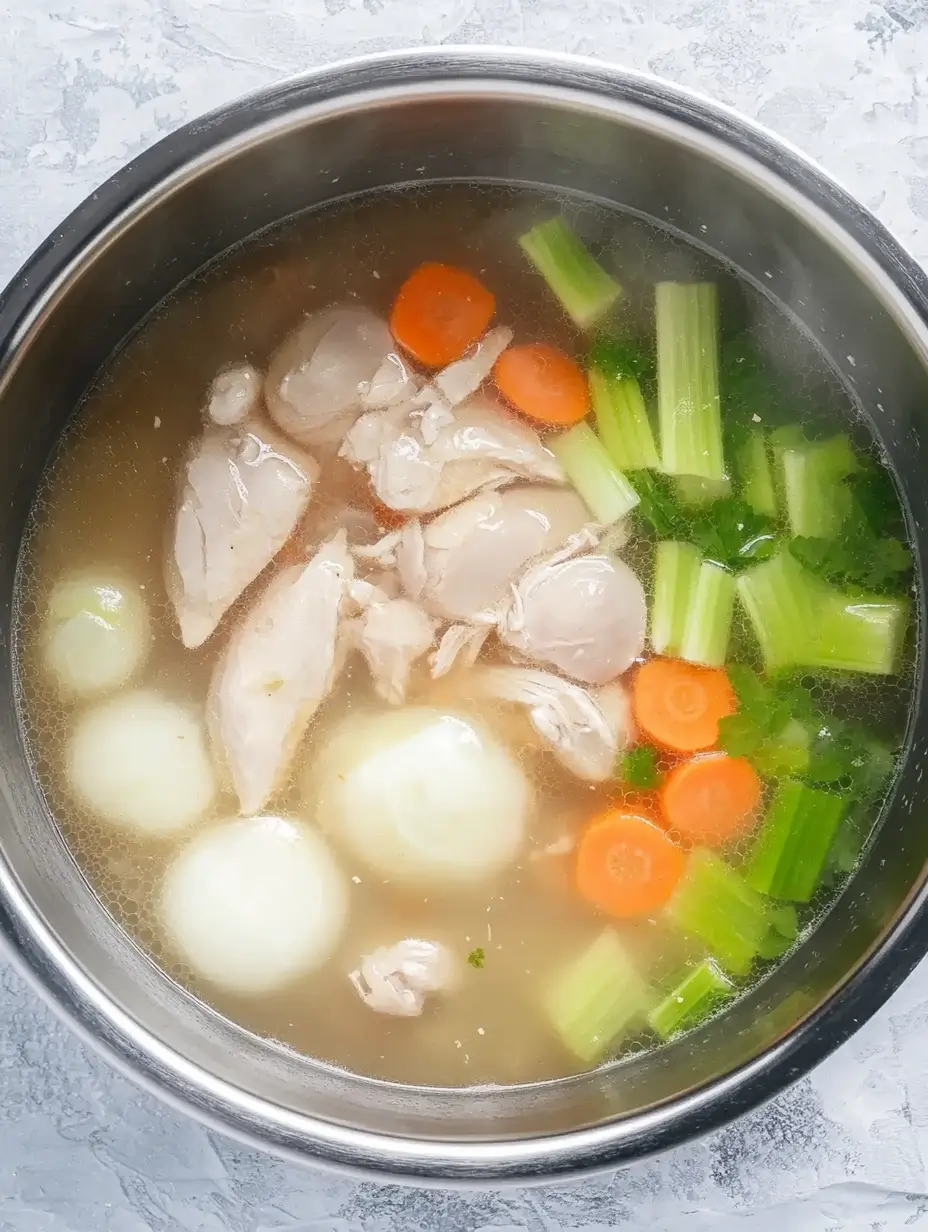Homemade chicken broth is a culinary skill that has made a really high-flavor dish very nutritious. Whereas store-bought ones are much cheaper, this multipurpose base for soups, stews, and sauces is free from preservatives. Moreover, by making your own soup, you can control the quality of your broth’s ingredients and have the best results in your recipes.
With a few simple ingredients and tools, you can prepare a broth that is rich in taste and nutrients. This article will walk you through the benefits, cost comparisons, essential ingredients, and a detailed guide to making your own homemade chicken broth.
Chicken Stock vs Homemade Chicken Broth: Key Differences
When cooking, many people use chicken broth and chicken stock interchangeably. However, there are key differences between the two, and understanding them can help you choose the right option for your recipe.
Chicken Broth
Broth is generally prepared by boiling meat, mostly with the addition of bones and fragrant vegetables, often onions, carrots, and celery. Its main characteristics include:
- Flavor: Light and savory, suitable for sipping or as a base for soups and sauces.
- Texture: Thin and less viscous because it lacks the high gelatin content of stock.
- Ingredients: Often includes seasonings like salt, which makes it ready to use without additional seasoning.
Broth is perfect for recipes where you want a lighter flavor or a ready-to-use liquid.
Chicken Stock
Chicken stock is made primarily by simmering bones, often roasted, along with vegetables and herbs. Unlike broth, it is cooked for a longer time, which extracts more nutrients and gelatin. Its defining features are:
- Flavor: Tasty and smooth, making it great for full-bodied stews and rich braises.
- Texture: Somewhat thicker due to release of gelatin from bones.
- Ingredients: Generally unsalted so you can adjust amount of salt and other spices as you desire in your recipe.
Stock is best suited for recipes where you want a fuller, deeper flavor or need a thicker base.
Key Differences at a Glance
| Feature | Chicken Broth | Chicken Stock |
|---|---|---|
| Main Ingredient | Meat (with or without bones) | Bones (with little to no meat) |
| Cooking Time | Shorter (1–2 hours) | Longer (3–6 hours or more) |
| Texture | Thin | Thicker due to gelatin |
| Flavor | Light and savory | Rich and deep |
| Seasoning | Often seasoned | Typically unseasoned |
Which Should You Use?
Use chicken broth for soups, light sauces, and dishes where a milder flavor is desired. On the other hand, chicken stock use it for stews, gravies, and recipes that require a more concentrated flavor.
Both homemade chicken broth and chicken stock have their place in the kitchen. So, choosing the right one can lift your cooking up, adding the perfect balance of flavor and texture to your dishes.
Why Make Chicken Broth at Home?
Nothing beats homemade chicken broth, and it beats store-bought hands down in terms of quality and benefits. Here’s why you should consider it:
- Control over ingredients: You can have fresh and good quality chicken along with vegetables without any added additives or high sodium levels with a control over ingredients.
- Customizable flavor: You can make them add spices and herbs according to your recipe preferences.
- Cost-effective: In the long run, this will prove to be more economical as one would have to spend time initially making broth at home.
In addition, making your own broth reduces food waste. For example, you can use leftover chicken bones and vegetable scraps to create a flavorful and nutrient-rich broth.
Health Benefits of Homemade Chicken Broth
Homemade chicken broth is a nutrient-rich drink that brings better health. Here is an overview of its benefits:
- Rich in collagen: Chicken bones release collagen during cooking, which supports skin health and joint function.
- Boosts immunity: The broth possesses calcium, magnesium and phosphorus minerals that formulate excellent contributions towards a yielding immune system.
- Easily digestible nutrients: Homemade chicken broth digests easily for people’s stomachs and even helps with digestion easily as a remedy during illness.
- Low in fat and sodium: When prepared at home, you can control the amount of fat and salt, ensuring a healthier broth compared to store-bought versions.
Choosing the Right Chicken Parts

To create a flavorful and nutritious broth, selecting the right chicken parts is crucial. Here are some tips:
- Chicken bones: Use a mix of chicken carcasses, necks, and wings, as they release gelatin and flavor during cooking.
- Meaty parts: Adding drumsticks or thighs boost the richness of the broth.
- Leftover scraps: Save bones and meat from roasted or cooked chicken for later use in broth.
The ideal broth is formed by a combination of bones, meat and cartilage in appropriate proportions.
Spices and Herbs for Flavor
The flavor of your homemade chicken broth depends on the spices and herbs you use. Consider the following:
- Basic spices: Salt, black peppercorns, and bay leaves provide a foundation of flavor.
- Herbs: Add fresh or dried thyme, parsley, and rosemary for an aromatic touch.
- Optional add-ins:
- Garlic cloves for depth.
- Ginger for a warming, earthy note.
You can customize the herbs and spices depending on how you plan to use the broth.
Tools and Equipment You’ll Need
Before you start making homemade chicken broth, gather the necessary tools:
- Large stockpot: A deep pot allows the ingredients to simmer evenly.
- Strainer or colander: Used to separate solids from the liquid broth.
- Cheesecloth: Helps strain finer particles for a clear broth.
- Storage containers: Airtight jars or freezer-safe bags for storing the broth.
Using the right equipment ensures a smooth preparation process and optimal results.
Step-by-Step Guide to Cooking Homemade Chicken Broth

Follow this detailed guide to prepare homemade chicken broth at home:
- Gather ingredients:
- Chicken parts (bones, wings, or leftover carcasses).
- Chopped vegetables (carrots, celery, onions).
- Spices and herbs (salt, peppercorns, bay leaves, thyme).
- Prepare the pot:
- Place the chicken parts and vegetables in a large stockpot.
- Add enough water to cover the ingredients by 2–3 inches.
- Simmer the broth:
- Bring the mixture to a boil over medium-high heat.
- Reduce to a low simmer and skim off any foam or impurities.
- Add seasoning:
- Add herbs and spices, adjusting quantities based on your taste preferences.
- Cook thoroughly:
- Simmer for 4–6 hours, allowing the flavors to develop.
- Strain the broth:
- Use a colander lined with cheesecloth to separate the liquid from solids.
- Cool and store:
- Let the broth cool to room temperature before transferring it to storage containers.
- Refrigerate for up to 5 days or freeze for longer shelf life.
By following these steps, you can prepare a broth that is both healthy and delicious.
Preparing the Ingredients
Freshly selected ingredients are the beginning to making your own chicken broth. These are aromatic vegetables and herbs. Important components are:
- Chicken parts: Use a whole chicken, carcass, or bone-in parts like wings and drumsticks.
- Vegetables: Carrots, celery, and onions form the classic aromatic base.
- Herbs and spices: Bay leaves, parsley, thyme, and black peppercorns make the flavor better.
- Water: Always use cold water for extracting flavors gradually.
Rinse the chicken to remove impurities and chop vegetables into large chunks. This simple preparation guarantees your broth is rich and clear.
Stovetop, Slow Cooker, or Instant Pot: Which is Best for Chicken Broth?
Homemade chicken broth can be prepared using different methods, each offering unique benefits. Each method offers unique benefits:
- Stovetop: Ideal for traditionalists, simmering on low heat for 3–4 hours.
- Slow cooker: Hands-free and convenient, cook for 6–8 hours on low for a deep, rich flavor.
- Instant Pot: For a quicker option, pressure-cook the broth for 30–40 minutes.
From all possible techniques, fastest and the earliest possible skim all impurities off the surface, so you end up with a clear broth.
Tips for Roasting Ingredients to Enhance Your Chicken Broth
Roasting ingredients adds depth to your homemade chicken broth. To do this:
- Spread chicken bones and vegetables on a baking sheet.
- Drizzle with oil and roast at 400°F (200°C) for 25–30 minutes.
- Add the roasted ingredients to your pot or slow cooker.
Adjusting Seasoning Levels
Seasoning your homemade chicken broth correctly is crucial:
- Start with minimal salt to prevent over-seasoning, especially if the broth will be reduced later.
- Add herbs and spices during the cooking process but adjust flavors toward the end.
- Taste periodically to test the balanced seasoning.
Additionally, For customization, add garlic, ginger, or turmeric for unique flavor profiles.
Storing and Preserving Chicken Broth
Proper storage extends the shelf life of your homemade chicken broth:
- Cool the broth quickly to avoid bacterial growth.
- Store in airtight containers or mason jars in the refrigerator for up to 5 days.
- For longer storage, freezing is the best option.
Label containers with the date to keep track of freshness.
Freezing and Storing Homemade Broth for Maximum Freshness
Freezing homemade chicken broth helps keep its taste and makes it easy to use later. Ice cube trays work well for dividing the broth into small portions that you can thaw quickly.
You can also use silicone freezer bags, which take up less space and are easy to store in your freezer.
When freezing, leave some space in the containers. This will prevent them from breaking as the broth expands when it freezes.
Freezing your broth is a simple way to always have fresh, healthy broth ready to use in your cooking.
Creative Recipes Using Homemade Chicken Broth
Using homemade chicken broth as a base for soups, stews, and sauces is one of the most effective ways to enhance your dishes’ flavor depth. Its versatility makes it an essential ingredient in kitchens worldwide.
Soups
Homemade chicken broth is the heart of many soup recipes. Some popular uses include:
- Chicken Noodle Soup: Combine chicken broth with shredded chicken, egg noodles, and vegetables for a comforting classic.
- Creamy Soups: Use broth as the base for creamy soups like broccoli cheddar or potato soup. Blend with cream or a roux for the perfect texture.
- Vegetable Soups: Add seasonal vegetables, herbs, and spices to your broth for a healthy, hearty meal.
Stews
Stews rely on the robust flavor of homemade chicken broth to create their rich, hearty character. Use broth in:
- Beef or Chicken Stews: Simmer meat, root vegetables, and broth together for hours to develop deep flavors.
- Vegetarian Stews: Combine beans, lentils, and vegetables with broth for a plant-based option that doesn’t compromise on taste.
- Asian-inspired Stews: Infuse the broth with ginger, soy sauce, and sesame oil for a delicious twist.
Sauces
Homemade chicken broth used for making sauces gives an incredibly rich, silky, flavorful sauce. Some of its uses as:
- Gravy: Reduce chicken broth with pan drippings and thicken with a roux for a smooth, savory gravy.
- Pan Sauces: Deglaze pans with broth to create a flavorful sauce for roasted chicken, pork, or beef.
- Cream Sauces: Incorporate broth into cream-based sauces for pasta, like Alfredo or creamy mushroom sauce, for an extra layer of flavor.
Pro Tips
- For a bolder taste in soups and stews, use roasted homemade chicken broth.
- Simmer sauces with fresh herbs like rosemary or thyme to amplify the aroma.
- Thicken sauces with a slurry of cornstarch or flour mixed with broth for a consistent texture.
By incorporating homemade chicken broth into soups, stews, and sauces, you’ll boost everyday dishes into something extraordinary.
Using Chicken Broth for Flavorful Rice, Quinoa, and Grains
Homemade chicken stock makes the grains so rich and flavorful:
- First, replace water with broth when cooking rice, quinoa, or couscous.
- Second, add broth to risottos for a creamy, savory base.
- Lastly, use it in grain-based salads to boost taste and nutrition.
This simple substitution transforms ordinary grains into exceptional side dishes.
FAQs
Is chicken broth just boiled chicken water?
No, chicken broth is not just boiled chicken water. It is made by simmering chicken (with or without bones) along with vegetables like carrots, celery, and onions, and herbs such as parsley and bay leaves. This process extracts flavors, nutrients, and richness from the ingredients, creating a savory and aromatic liquid. In contrast, plain boiled chicken water lacks the depth and complexity of flavor found in a properly made broth.
How is broth made from scratch?
Making homemade chicken broth is simple and requires only a few steps:
- Ingredients: Gather chicken parts (whole chicken, carcass, or bones), vegetables (carrots, celery, onions), and herbs (parsley, thyme, bay leaves, etc.).
- Preparation: Place the chicken and vegetables into a large pot. Cover them with cold water, ensuring there is enough liquid to submerge everything.
- Simmering: Heat the pot until the water comes to a gentle boil, then lower the heat to a simmer. Allow it to cook for 2–4 hours, skimming off foam and impurities periodically.
- Straining: When the time comes to finish, the liquid is drained through a fine-mesh sieve leaving a clean and clear flavorful broth free from any solids.
- Storing: Let the broth cool, then store it in the refrigerator for up to 5 days or freeze for longer storage.
Versatile and nourishing – such would be the broth obtained by this process and could improve several dishes.
Is homemade chicken broth good for you?
Yes, homemade chicken broth is highly beneficial for your health. It offers:
- Nutrients: Contains essential minerals like calcium, magnesium, and phosphorus, which support bone and overall health.
- Collagen and Gelatin: Promote joint health, improve digestion, and contribute to skin elasticity.
- Amino Acids: Such as glycine, which aids in detoxification and boosts immune function.
- Low Calories: Makes it a flavorful yet light addition to recipes.
Unlike store-bought options, homemade broth is free of artificial preservatives, excessive sodium, and other additives, making it a wholesome and nutritious choice.
Conclusion
Making chicken broth at home is quite a process, but the flavor and vitamin benefits in your diet are possibly the best things you have ever achieved in your kitchen. You can now get started on the ingredient hunting to being a little bit experimental with what you use. Master the broth-making portion of this chicken broth guide. Try it today and elevate your cooking to new heights!

